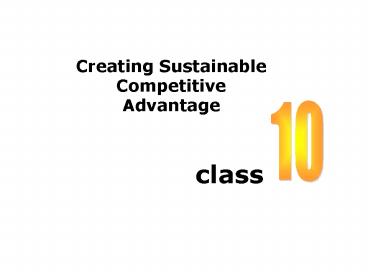Creating Sustainable Competitive Advantage PowerPoint PPT Presentation
1 / 49
Title: Creating Sustainable Competitive Advantage
1
Creating Sustainable Competitive Advantage
class
10
2
Using organizational resources to create
sustainable competitive advantage
- Organizational culture
- Marketing assets
- Marketing capabilities
3
Figure 11.1 Advantage-creating resources
4
Figure 11.2 Resource imitability ladder Source
Adapted from Collis and Montgomery (1997)
5
Figure 11.3 Generic routes to competitive
advantage creation
6
Cost Drivers
Scale
Institutional
Experience
Capacity Utilisation
Location
COSTS
Policy choices
Linkages
Inter-relationships
Timing
Integration
Source based on Porter (1985)
7
Figure 11.5 Uniqueness drivers
8
Figure 11.6 Levels of product/service offering
9
Levels of product/service offering
- Differentiating the core and expected product
- Differentiation of the core product or benefit
offers a different way of satisfying the same
basic want or need
10
Levels of product/service offering
- Augmenting the product
- Differentiation of the augmented product can be
achieved by offering more to customers on
existing features
11
Levels of product/service offering
- Quality
- A prime factor in differentiating the product or
service from that of competitors is quality
12
Levels of product/service offering
- Packaging
- Packaging Store
- Packaging Protects
- Packaging Facilitates use
- Packaging helps create an image
- Packaging helps promote
13
Levels of product/service offering
- Branding
- A particular effective way of differentiating at
the tangible product level is to create a unique
brand with a favorable image and reputation
14
Levels of product/service offering
- Service
- Service can be a major differentiating factor in
the purchase of many products, especially durable
15
Figure 11.7 Product/service differentiation
16
Figure 11.8 Alternative emphases for
differentiation
17
Figure 19.1 Pressures on marketing
18
Figure 19.2 Increasing customer demands
19
Figure 19.3 Fundamentals of strategy in a
changing world
20
Figure 19.4 Basic positioning options
21
Figure 19.5 Low-price positioning
22
Figure 19.6 Premium-quality positioning
23
Figure 19.7 Innovation positioning
24
Figure 19.8 Superior-service positioning
25
Figure 19.9 Differentiated positioning
26
Figure 19.10 Customised positioning
27
Offensive and defensive competitive strategies
28
Build Strategies
- A build strategy seeks to improve on
organizational performance through expansion of
activities
29
Strategies
- Expand the total market by
- Finding new users
- Creating new uses, and
- Encouraging more usage
- Protect its current market share by
- Adopting defense strategies Increase its market
share - Note the relationship between market share and
profitability
30
Expanding the Total Market
New customers
More usage
31
Expanding the Total Market
- New Customer
- Buyers who are unaware of product
- Buyer who are resisting because of price, lack of
certain features.
32
Expanding the Total Market
- Search new user among three groups
- Market penetration strategy
- New market segment strategy
- Geographical expansion strategy
33
Expanding the Total Market
- More Usage
- Increasing the level or quantity of consumption
- Increasing the frequency of consumption
34
Expanding the Total Market
- The amount of consumption can increased by
- Package
- Product design
- Additional opportunities to use the brand in the
same basic way - Identifying completely new
- Provide consumer with better information
- When the product was first used or would need to
be replaced - The current level of product performance
35
Figure 11.9 Market challenger strategies
36
Figure 11.10 Frontal attack
37
Figure 11.11 Flanking attack
38
Figure 11.12 Encirclement attack
39
Figure 11.13 Bypass strategy
40
Figure 11.14 Guerrilla tactics
41
Figure 11.15 Defensive strategies
42
Figure 11.16 Position defence
43
Figure 11.17 Flanking defence
44
Figure 11.18 Pre-emptive strike
45
Figure 11.19 Mobile defence
46
Figure 11.20 Contraction (focus) defence
47
Figure 11.21 Niche strategies
48
Figure 11.22 Harvesting strategies
49
Figure 11.23 Divestment strategies

